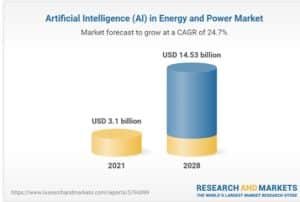AI is a powerful force driving innovation across industries in today’s rapidly evolving technological landscape. However, as AI capabilities expand, so does its appetite for energy. This phenomenon has brought the intersection of AI and energy into sharp focus, particularly in the context of global decarbonization efforts.
The Interplay of AI and Renewable Energy
The rise of AI has spurred an unprecedented demand for computing power, much of which is supplied by data centers.
These data giants consume vast amounts of electricity, prompting concerns about their environmental impact and contribution to carbon emissions. Some argue that these companies have the resources and the motivation to invest in cleaner energy technologies. They can also advocate for policy changes to support decarbonization efforts. However, others raise concerns about the environmental impact and the need for greater transparency and accountability in their sustainability initiatives.
Amidst the urgency to transition to renewable energy sources, the energy consumed by AI presents a significant challenge to decarbonization efforts.
On one side, the influx of demand from tech giants could provide a financial boost to investments in renewables, potentially accelerating the transition to cleaner energy sources. However, there remains a tangible risk that the energy demands of AI will be met using conventional, fossil fuel-based methods, such as natural gas or coal. This scenario would undermine progress toward decarbonization goals and perpetuate reliance on non-renewable resources.
Thus, navigating this decarbonization dilemma requires balancing the transformative potential of AI and mitigating its environmental impact.
- It calls for strategic investments in renewable energy infrastructure with AI technology innovation to optimize energy efficiency.
- Collaborative efforts between tech companies, energy providers, policymakers, and environmental advocates are essential to charting a sustainable path forward.
A Bloomberg analysis reported, that traditional energy corporations like PPL Corp., Alliant Energy Corp., WEC Energy Group Inc., Entergy Corp., Duke Energy Corp., NextEra Energy Inc., DTE Energy Co., CenterPoint Energy Inc., and Vistra Corp., are also deeply involved in navigating the challenges and opportunities presented by AI and data centers.
These companies face pressure to optimize their operations for efficiency, reliability, and sustainability. AI technologies offer opportunities to enhance grid management, predict demand more accurately, optimize energy distribution, and improve maintenance scheduling. Moreover, these corporations will likely explore AI-driven solutions to meet regulatory requirements and customer demands for cleaner energy sources.
As AI becomes increasingly integral to various industries, including energy, investors will evaluate companies based on their AI capabilities and ability to adapt to technological advancements.
The automation era in the energy sector
This futuristic vision is swiftly materializing – the AI in energy and power market is forecasted to surge at a CAGR of 24.68%, from a value of US$3.103 billion in 2021 to US$14.527 billion by 2028.
AI-Growth Drivers Transforming the Energy Companies
From predictive maintenance to demand forecast, AI-powered solutions are revolutionizing traditional practices and reshaping the industry.
1. Predictive Maintenance: Preventing Downtime, Maximizing Efficiency
By analyzing vast amounts of data from sensors and equipment, AI algorithms can detect anomalies and predict potential failures before they occur. This approach not only minimizes downtime but also maximizes the lifespan of critical assets. It further leads to substantial cost savings for energy companies.
2. Optimized Asset Management: Maximizing Returns on Investments
AI-driven asset management solutions enable energy companies to optimize the performance of their infrastructure. Through real-time monitoring and analysis, AI algorithms can identify opportunities for efficiency improvements and asset optimization. AI empowers companies to make data-driven decisions that enhance profitability and sustainability.
3. Dynamic Demand Forecasting: Balancing Supply and Demand
Accurate demand forecasting is essential for energy companies to manage supply and avoid costly overproduction or shortages. AI-powered demand forecasting models leverage historical data, weather patterns, market trends, and other variables to predict future demand with precision. By optimizing resource allocation and scheduling, energy companies can minimize waste and maximize revenue, ultimately improving cost efficiency.
4. Enhanced Customer Engagement: Personalized Services and Solutions
AI technologies also enable energy companies to enhance customer engagement by offering personalized services and solutions. Data analytics and machine learning empower companies to customize offerings based on individual customer preferences and behavior.
source: Data Dynamics
Moving on, we can see the top energy giants using AI in their operations
Top Energy Giants using AI in their Operations
These energy companies exemplify the strategic adoption of AI to enhance their operational capabilities, driving efficiency gains and ultimately contributing to their bottom line.
Exxon Mobil
Exxon Mobil integrates AI to enhance operational efficiency and reliability across its operations. It collaborates with IBM to use quantum computing in advancing AI-driven simulations. Additionally, they use AI for critical calculations to optimize CCS methods.
- Enhances its operational efficiency, minimizes downtime, and reduces maintenance costs with AI-driven predictive maintenance and process optimization.
- The AI-powered analytics enable the company to optimize supply chain management.
- Subsequently, it ensures timely delivery of products to customers while minimizing transportation costs and environmental impact.
ABB
The Swiss technology leader in electrification and automation is a pioneer in AI usage. The company
- Utilizes AI to identify faults like pipeline and machinery cracks through image analysis.
- Manages distributed energy resources for reliable green power.
- Employs AI to analyze seismic data for optimizing oil extraction.
Schneider Electric
It uses Microsoft’s machine learning to remotely monitor and configure pumps in oil and gas fields. AI can detect pump failures, prevent weeks of downtime, and repair costs of up to $1 million.
BP
The London-based gas and oil giant leverages AI to enhance decision-making processes, optimize resource allocation, and improve safety standards. AI boosts the oil extraction and recovery process with high-end sensors. It further lowers the cost/ barrel, reduces risk, and ensures compliance.
Notably, BP is one of Amazon’s most trusted cloud computing clients. It has used its technology to enhance the performance of its lubricants ERP system with 40% faster response times.
Royal Dutch Shell
Shell implements AI technologies to streamline operations, drive innovation, and enhance overall performance. It utilizes Microsoft’s cloud-centric platform, Azure. By leveraging AI technologies, Shell aims to boost revenue, cut costs, and enhance operational safety, such as monitoring data from drill sensors deep underground.
Gretchen Watkins, President of Shell Oil Company, revealed at the CERAWeek energy conference that,
Shell employs AI algorithms for drilling in wells in the Permian Basin. These algorithms, driven by machine learning, facilitate safe, reliable, and cost-effective operations.
The Top 10 AI-powered solutions in the Energy and Power Sector and their Stocks to Watch Out
The U.S. Department of Energy established the Artificial Intelligence and Technology Office (AITO) to elevate it into a global leader in AI
AITO is responsible for reliable AI governance and capabilities in energy infrastructure, advising on trustworthy AI/ML strategies. It fosters partnerships, policies, and innovations in AI and energy across public, private, and international sectors. AITO further supports Department of Energy program offices to implement AI/ML strategies.
Overall, the relationship between AI, energy, and decarbonization efforts is complex and multifaceted, and addressing the challenges will require collaboration across industries and disciplines.




